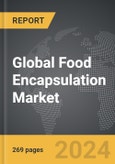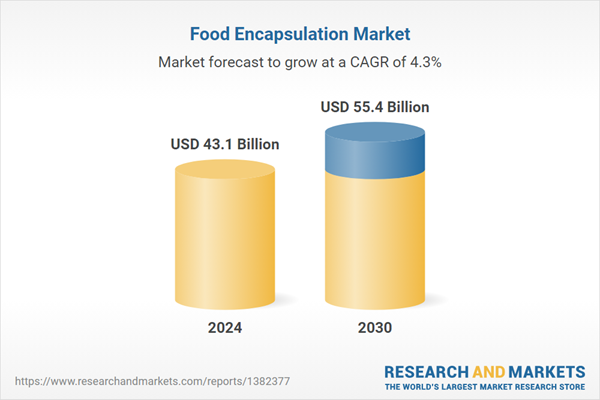The global market for Food Encapsulation was valued at US$43.1 Billion in 2024 and is projected to reach US$55.4 Billion by 2030, growing at a CAGR of 4.3% from 2024 to 2030. This comprehensive report provides an in-depth analysis of market trends, drivers, and forecasts, helping you make informed business decisions.
Advancements in encapsulation technology have significantly broadened its applications and efficacy in the food industry. Techniques such as spray drying, coacervation, extrusion, and liposomal encapsulation have been refined to improve encapsulation efficiency and control release profiles. Spray drying, for example, is widely used for its cost-effectiveness and scalability, suitable for encapsulating flavors and oils. Liposomal encapsulation, on the other hand, offers a more sophisticated method for incorporating sensitive bioactive compounds like vitamins and probiotics, protecting them from degradation and ensuring their bioavailability upon consumption. Additionally, nanotechnology has emerged as a game-changer in food encapsulation, enabling the development of nano-encapsulated ingredients with enhanced stability and targeted release properties. These technological advancements have allowed food manufacturers to create products with improved texture, flavor, and nutritional profile, meeting the diverse demands of modern consumers.
Food encapsulation is a sophisticated process used in the food industry to incorporate active ingredients, such as flavors, vitamins, probiotics, and preservatives, within a protective coating. This technique serves multiple purposes, including enhancing the stability of the encapsulated ingredients, controlling their release, and masking undesirable tastes or odors. Encapsulation materials can range from natural biopolymers like alginate, chitosan, and gelatin, to synthetic polymers. The selection of these materials depends on the desired properties of the final product, such as solubility, release mechanism, and interaction with the food matrix. Food encapsulation not only improves the shelf life and effectiveness of active ingredients but also enables the development of functional foods with targeted health benefits, appealing to health-conscious consumers seeking specific nutritional enhancements.
Food Encapsulation - Key Trends and Drivers
The growth in the food encapsulation market is driven by several factors. Increasing consumer demand for functional and fortified foods is a significant driver, as more people seek products that offer additional health benefits. Technological advancements in encapsulation methods have made it possible to incorporate a wider range of active ingredients into food products more effectively. The rise of health-conscious consumers and the growing awareness of the benefits of probiotics, vitamins, and other bioactive compounds are propelling the market forward. Additionally, the expanding convenience food sector, which requires long shelf life and stability of ingredients, is fueling the demand for advanced encapsulation technologies. Regulatory support for the use of encapsulation in food processing and the development of new encapsulation materials that are safe and effective further bolster market growth. These factors collectively highlight the dynamic nature of the food encapsulation market, underscoring its critical role in the innovation and development of new food products.Advancements in encapsulation technology have significantly broadened its applications and efficacy in the food industry. Techniques such as spray drying, coacervation, extrusion, and liposomal encapsulation have been refined to improve encapsulation efficiency and control release profiles. Spray drying, for example, is widely used for its cost-effectiveness and scalability, suitable for encapsulating flavors and oils. Liposomal encapsulation, on the other hand, offers a more sophisticated method for incorporating sensitive bioactive compounds like vitamins and probiotics, protecting them from degradation and ensuring their bioavailability upon consumption. Additionally, nanotechnology has emerged as a game-changer in food encapsulation, enabling the development of nano-encapsulated ingredients with enhanced stability and targeted release properties. These technological advancements have allowed food manufacturers to create products with improved texture, flavor, and nutritional profile, meeting the diverse demands of modern consumers.
Food encapsulation is a sophisticated process used in the food industry to incorporate active ingredients, such as flavors, vitamins, probiotics, and preservatives, within a protective coating. This technique serves multiple purposes, including enhancing the stability of the encapsulated ingredients, controlling their release, and masking undesirable tastes or odors. Encapsulation materials can range from natural biopolymers like alginate, chitosan, and gelatin, to synthetic polymers. The selection of these materials depends on the desired properties of the final product, such as solubility, release mechanism, and interaction with the food matrix. Food encapsulation not only improves the shelf life and effectiveness of active ingredients but also enables the development of functional foods with targeted health benefits, appealing to health-conscious consumers seeking specific nutritional enhancements.
Report Scope
The report analyzes the Food Encapsulation market, presented in terms of market value (USD). The analysis covers the key segments and geographic regions outlined below.Segments
Core Phase (Probiotics & Prebiotics, Vitamins, Minerals, Preservatives & Colors, Enzymes, Organic Acids, Other Core Phases).Geographic Regions/Countries
World; United States; Canada; Japan; China; Europe (France; Germany; Italy; United Kingdom; Spain; Russia; and Rest of Europe); Asia-Pacific (Australia; India; South Korea; and Rest of Asia-Pacific); Latin America (Argentina; Brazil; Mexico; and Rest of Latin America); Middle East (Iran; Israel; Saudi Arabia; United Arab Emirates; and Rest of Middle East); and Africa.Key Insights:
- Market Growth: Understand the significant growth trajectory of the Probiotics & Prebiotics segment, which is expected to reach US$11.8 Billion by 2030 with a CAGR of a 6.2%. The Vitamins segment is also set to grow at 4% CAGR over the analysis period.
- Regional Analysis: Gain insights into the U.S. market, valued at $11.5 Billion in 2024, and China, forecasted to grow at an impressive 7.5% CAGR to reach $12 Billion by 2030. Discover growth trends in other key regions, including Japan, Canada, Germany, and the Asia-Pacific.
Why You Should Buy This Report:
- Detailed Market Analysis: Access a thorough analysis of the Global Food Encapsulation Market, covering all major geographic regions and market segments.
- Competitive Insights: Get an overview of the competitive landscape, including the market presence of major players across different geographies.
- Future Trends and Drivers: Understand the key trends and drivers shaping the future of the Global Food Encapsulation Market.
- Actionable Insights: Benefit from actionable insights that can help you identify new revenue opportunities and make strategic business decisions.
Key Questions Answered:
- How is the Global Food Encapsulation Market expected to evolve by 2030?
- What are the main drivers and restraints affecting the market?
- Which market segments will grow the most over the forecast period?
- How will market shares for different regions and segments change by 2030?
- Who are the leading players in the market, and what are their prospects?
Report Features:
- Comprehensive Market Data: Independent analysis of annual sales and market forecasts in US$ Million from 2024 to 2030.
- In-Depth Regional Analysis: Detailed insights into key markets, including the U.S., China, Japan, Canada, Europe, Asia-Pacific, Latin America, Middle East, and Africa.
- Company Profiles: Coverage of players such as ABCO Laboratories Inc., Advanced BioNutrition Corporation, Aveka Inc., AVEKA, Inc., Balchem Corporation and more.
- Complimentary Updates: Receive free report updates for one year to keep you informed of the latest market developments.
Some of the 33 companies featured in this Food Encapsulation market report include:
- ABCO Laboratories Inc.
- Advanced BioNutrition Corporation
- Aveka Inc.
- AVEKA, Inc.
- Balchem Corporation
- Cargill Inc.
- Coating Place Inc.
- Encapsys LLC
- Firmenich Inc.
- FrieslandCampina Kievit
- LycoRed Ltd.
- Maxx Performance Inc.
- Royal DSM N.V.
- Sensient Technologies Corporation
- Symrise AG
- Taste Tech Ltd.
Table of Contents
I. METHODOLOGYII. EXECUTIVE SUMMARY2. FOCUS ON SELECT PLAYERSIII. MARKET ANALYSISSOUTH KOREAREST OF ASIA-PACIFICARGENTINABRAZILMEXICOREST OF LATIN AMERICAIRANISRAELSAUDI ARABIAUNITED ARAB EMIRATESREST OF MIDDLE EASTIV. COMPETITION
1. MARKET OVERVIEW
3. MARKET TRENDS & DRIVERS
4. GLOBAL MARKET PERSPECTIVE
UNITED STATES
CANADA
JAPAN
CHINA
EUROPE
FRANCE
GERMANY
ITALY
UNITED KINGDOM
SPAIN
RUSSIA
REST OF EUROPE
ASIA-PACIFIC
AUSTRALIA
INDIA
LATIN AMERICA
MIDDLE EAST
AFRICA
Companies Mentioned (Partial List)
A selection of companies mentioned in this report includes, but is not limited to:
- ABCO Laboratories Inc.
- Advanced BioNutrition Corporation
- Aveka Inc.
- AVEKA, Inc.
- Balchem Corporation
- Cargill Inc.
- Coating Place Inc.
- Encapsys LLC
- Firmenich Inc.
- FrieslandCampina Kievit
- LycoRed Ltd.
- Maxx Performance Inc.
- Royal DSM N.V.
- Sensient Technologies Corporation
- Symrise AG
- Taste Tech Ltd.
Table Information
| Report Attribute | Details |
|---|---|
| No. of Pages | 269 |
| Published | February 2025 |
| Forecast Period | 2024 - 2030 |
| Estimated Market Value ( USD | $ 43.1 Billion |
| Forecasted Market Value ( USD | $ 55.4 Billion |
| Compound Annual Growth Rate | 4.3% |
| Regions Covered | Global |









